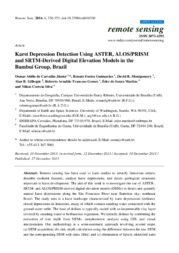Karst depression detection using ASTER, ALOS/PRISM and SRTM-Derived digital elevation models in the Bambuí Group, Brazil.
Karst depression detection using ASTER, ALOS/PRISM and SRTM-Derived digital elevation models in the Bambuí Group, Brazil.
Author(s): CARVALHO JÚNIOR, O. A. de; GUIMARÃES, R. F.; MONTGOMERY, D. R.; GILLESPIE, A. R.; GOMES, R. A. T.; MARTINS, E. de S.; SILVA, N. C.
Summary: Abstract: Remote sensing has been used in karst studies to identify limestone terrain, describe exokarst features, analyze karst depressions, and detect geological structures important to karst development. The aim of this work is to investigate the use of ASTER-, SRTM- and ALOS/PRISM-derived digital elevation models (DEMs) to detect and quantify natural karst depressions along the São Francisco River near Barreiras city, northeast Brazil. The study area is a karst landscape characterized by karst depressions (dolines), closed depressions in limestone, many of which contain standing water connected with the ground-water table. The base of dolines is typically sealed with an impermeable clay layer covered by standing water or herbaceous vegetation. We identify dolines by combining the extraction of sink depth from DEMs, morphometric analysis using GIS, and visual interpretation. Our methodology is a semi-automatic approach involving several steps: (a) DEM acquisition; (b) sink-depth calculation using the difference between the raw DEM and the corresponding DEM with sinks filled; and (c) elimination of falsely identified karst depressions using morphometric attributes. The advantages and limitations of the applied methodology using different DEMs are examined by comparison with a sinkhole map generated from traditional geomorphological investigations based on visual interpretation of the high-resolution remote sensing images and field surveys. The threshold values of the depth, area size and circularity index appropriate for distinguishing dolines were identified from the maximum overall accuracy obtained by comparison with a true doline map. Our results indicate that the best performance of the proposed methodology for meso-scale karst feature detection was using ALOS/PRISM data with a threshold depth > 2 m; areas > 13,125 m2 and circularity indexes > 0.3 (overall accuracy of 0.53). The overall correct identification of around half of the true dolines suggests the potential to substantially improve doline identification using higher-resolution LiDAR-generated DEMs.
Publication year: 2014
Types of publication: Journal article
Unit: Embrapa Cerrados
Observation
Some of Embrapa's publications are published as ePub files. To read them, use or download one of the following free software options to your computer or mobile device. Android: Google Play Books; IOS: iBooks; Windows and Linux: Calibre.
Access other publications
Access the Agricultural Research Database (BDPA) to consult Embrapa's full library collection and records.
Visit Embrapa Bookstore to purchase books and other publications sold by Embrapa.

